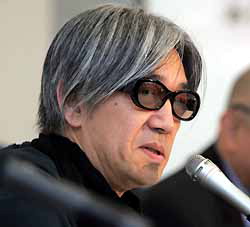 Japanese scientists researching the prospects of long-term human settlements on Mars are dreaming up ways to address the challenges of Martian agriculture. At a recent meeting of the Japan Geoscience Union held in Chiba, Professor Masamichi Yamashita (58) of the Japan Aeropsace Exploration Agency (JAXA) unveiled a unique space agriculture concept that would liven up the rather mundane task of cultivating rice in greenhouse domes. In his concept, settlers would plant mulberry trees and breed silkworms, the pupae of which would be consumed as a source of animal protein.
Japanese scientists researching the prospects of long-term human settlements on Mars are dreaming up ways to address the challenges of Martian agriculture. At a recent meeting of the Japan Geoscience Union held in Chiba, Professor Masamichi Yamashita (58) of the Japan Aeropsace Exploration Agency (JAXA) unveiled a unique space agriculture concept that would liven up the rather mundane task of cultivating rice in greenhouse domes. In his concept, settlers would plant mulberry trees and breed silkworms, the pupae of which would be consumed as a source of animal protein.
"Japan has the unique advantage of calling into play its excellent silk cultivation technology and long-established culinary culture," says Yamashita, who has been studying the subject since January 2005. As part of his research, Professor Yamashita has met with about 70 experts in fields ranging from medicine to agriculture to food science. "Space agriculture research is about the pursuit of near-complete recycling inside domes, something that can also be applied to safe organic agriculture on Earth," he says.
With trips to Mars taking 18 months each way, settlers will not be able to rely on frequent supply shipments from Earth. A self-sufficient supply of oxygen and food will be essential to the succes of any lengthy stay on Mars. The thin Martian atmosphere and a sunlight intensity half that on Earth pose additional agricultural challenges, and the unwillingness to taint the search for extraterrestrial life with microorganism-laden human and animal waste demands a rigorous recycling program.
Yamashita's concept involves the construction of transparent resin domes where rice, beans, potatoes, and mulberries are grown in soil consisting of a mixture of Martian sand and compost material. The plants would generate oxygen inside the domes, and the mulberry leaves would serve as food for the silkworms. The settlers could then either eat the silkworm pupae directly or use them as food for fish and poultry they raise.
"When cooked, silkworm pupae taste like shrimp or crab meat," says Professor Yamashita. "People all over Japan ate them during the food shortages after World War II, and you can still buy canned pupae in Nagano prefecture."
[Source: Nishinippon Shimbun]



 An assortment of model "safe" homes shaped like soccer balls are on display at a home exhibition in suburban Gifu. The homes -- named "Barier" by manufacturer
An assortment of model "safe" homes shaped like soccer balls are on display at a home exhibition in suburban Gifu. The homes -- named "Barier" by manufacturer  Final preparations are being made for the launch of a project to develop space yogurt. The plan is a follow-up to the
Final preparations are being made for the launch of a project to develop space yogurt. The plan is a follow-up to the  Chatty, a talking mannequin with a human face, is on display at the
Chatty, a talking mannequin with a human face, is on display at the  As the number of willing blood donors in Japan continues to decline, the
As the number of willing blood donors in Japan continues to decline, the  At a press conference held in Tokyo on March 23, composer Ryuichi Sakamoto made a public appeal to the government to exempt all secondhand electrical goods from the Electrical Appliance and Material Safety Law (a.k.a. PSE Law, or DENAN). The law, which is set to take effect April 1, will prohibit businesses from selling electrical goods that do not bear the PSE mark (that signifies compliance with the law?s safety standards). In other words, before putting products up for sale, dealers will be forced to file paperwork and perform tests (such as 1,000 volts for one minute) on each and every pre-2002 electrical product in order to obtain a PSE mark. Though the government recently revised the law so that it does not apply to certain "vintage" electric instruments with high scarcity value, Sakamoto called upon the government to expand the exemption to all secondhand electrical goods.
At a press conference held in Tokyo on March 23, composer Ryuichi Sakamoto made a public appeal to the government to exempt all secondhand electrical goods from the Electrical Appliance and Material Safety Law (a.k.a. PSE Law, or DENAN). The law, which is set to take effect April 1, will prohibit businesses from selling electrical goods that do not bear the PSE mark (that signifies compliance with the law?s safety standards). In other words, before putting products up for sale, dealers will be forced to file paperwork and perform tests (such as 1,000 volts for one minute) on each and every pre-2002 electrical product in order to obtain a PSE mark. Though the government recently revised the law so that it does not apply to certain "vintage" electric instruments with high scarcity value, Sakamoto called upon the government to expand the exemption to all secondhand electrical goods.